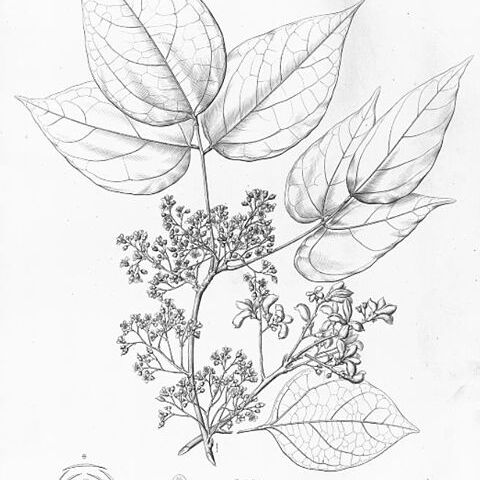Lianas, climbing shrubs, or small trees. Branchlets glabrous. Leaves alternate, exstipulate, petiolate, odd-pinnate or 3-foliolate, rarely 1-foliolate; leaflets subopposite or alternate; leaflet blade entire at margin, usually with pellucid glands. Inflorescences mostly terminal, paniculate, large, or rarely subcymose or racemose in distal leaf axils. Flowers bisexual, fragrant. Sepals, petals, and stamens usually glandular. Sepals (4 or)5, broadly imbricate or subvalvate in bud, slightly connate at base, thick and fleshy, persistent but not enlarged after anthesis. Petals 5, free, subequaling or slightly longer than sepals, often coherent at middle, imbricate in bud. Stamens ca. 10, alternately longer and shorter, 5 long ones opposite sepals, 5 short ones opposite petals and often abortive; filaments connate at base; anthers oblong, locules often glandular at base; connective glandular at apex. Carpel 1; ovary globose, 1-loculed, pilose; ovules 2, collateral. Style slender, proximal 1/2 pilose, distal 1/2 glandular pubescent; stigma uniform, oblique. Follicle slightly compressed, sometimes narrowed at base into a long, slender stipe (stipe sometimes thick or almost absent), striate, dehiscing longitudinally along adaxial or sometimes abaxial suture, with persistent calyx, apex obtuse and usually shortly beaked; pericarp woody or leathery. Seed 1, somewhat reniform; testa mostly black-purple, glossy; aril cupular, crenulate or laciniate, fleshy; endosperm absent.
Shrubs, trees or lianes, branches glabrous or with simple or sympodially branched hairs. Leaves imparipinnate, trifoliolate or rarely unifoliolate, entire, opposite or sub-opposite. Inflorescence terminal, paniculate, or rarely axillary and cymose or racemose. Flowers with heteromorphic androecium and gynoecium. Sepals 5, rarely 4, imbricate or rarely subvalvate. Petals 5, usually longer than sepals, glabrous to densely pubescent, sometimes with glandular hairs; both sepals and petals dotted with blackish glandular cavities. Stamens 10; epipetalous stamens sometimes staminodal or reduced with functionless anthers; filaments connate into short basal tube, anthers ± oblong, both filaments and anthers with scattered glandular papillae. Carpel solitary; ovary ovoid, pubescent, style often with glandular papillae, stigma expanded; ovules inserted on ventral suture. Fruit an obliquely pyriform, fusiform or cymbiform follicle, apex obliquely mucronate or tapering into a curved rostrum, base narrowing into a slender stipe; dehiscence usually along ventral suture; pericarp woody, horny or tough and parchment-like, obliquely and conspicuously lined with raised striae, usually glabrous, sometimes with blackish glandular lacunae. Testa dark and shining, hilum lateral; aril bilobed, spreading posteriorly to enclose seed-base; cotyledons thick, radicle usually apical; endosperm absent or little-developed.
Woody lianas, shrubs, or trees. Leaves imparipinnate, rarely unifoliolate. In-florescence paniculate, terminal and lateral in the upper leaf axils. Flowers small, glandular; sepals imbricate to subvalvate, more or less conspicuously punctate-glandular, not enlarged in fruit; petals glandular or eglandular; stamens 10, or the inner whorl reduced to staminodia, the filament and connective bearing small, sessile or stipitate glands; carpels 1. Fruit a stipitate, gibbous follicle containing a single arillate seed.

